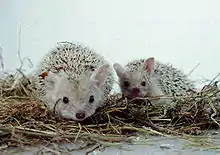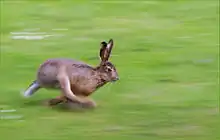List of mammals of Iraq
The list of mammals of Iraq comprises seventy-eight mammal species, of which one is endangered, eleven are vulnerable, and three are near threatened. One of the species is probably locally extinct in the wild.[1]
The following tags are used to highlight each species' conservation status as assessed on the IUCN Red List:
| EX | Extinct | No reasonable doubt that the last individual has died. |
| EW | Extinct in the wild | Known only to survive in captivity or as a naturalized populations well outside its previous range. |
| CR | Critically endangered | The species is in imminent risk of extinction in the wild. |
| EN | Endangered | The species is facing an extremely high risk of extinction in the wild. |
| VU | Vulnerable | The species is facing a high risk of extinction in the wild. |
| NT | Near threatened | The species does not meet any of the criteria that would categorise it as risking extinction but it is likely to do so in the future. |
| LC | Least concern | There are no current identifiable risks to the species. |
| DD | Data deficient | There is inadequate information to make an assessment of the risks to this species. |
Order: Artiodactyla (even-toed ungulates)
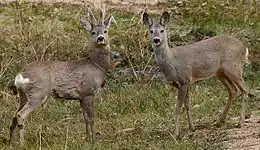
The even-toed ungulates are ungulates whose weight is borne about equally by the third and fourth toes, rather than mostly or entirely by the third as in perissodactyls. There are about 220 artiodactyl species, including many that are of great economic importance to humans.
- Family: Bovidae (cattle, antelope, sheep, goats)
- Subfamily: Antilopinae
- Genus: Gazella
- Arabian sand gazelle, G. marica VU[2]
- Goitered gazelle, G. subgutturosa VU[3] presence uncertain
- Genus: Gazella
- Subfamily: Caprinae
- Subfamily: Antilopinae
- Family: Cervidae (deer)
- Subfamily: Capreolinae
- Family: Suidae (pigs)
Order: Carnivora
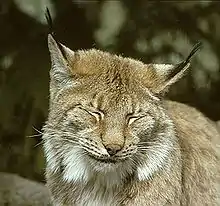
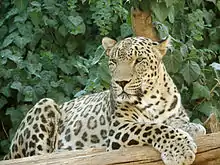
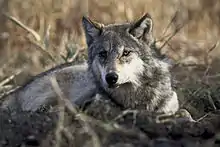
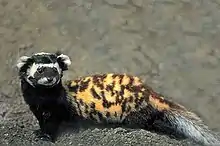
There are over 260 species of carnivorans, the majority of which feed primarily on meat. They have a characteristic skull shape and dentition.
- Suborder: Feliformia
- Family: Felidae (cats)
- Subfamily: Felinae
- Genus: Caracal
- Genus: Felis
- Jungle cat, F. chaus LC[8]
- African wildcat, F. lybica
- Sand cat, F. margarita LC[9]
- Genus: Lynx
- Eurasian lynx, L. lynx LC[10]
- Subfamily: Pantherinae
- Genus: Panthera
- Leopard, P. pardus
- Persian leopard, P. p. tulliana EN[11]
- Leopard, P. pardus
- Genus: Panthera
- Subfamily: Felinae
- Family: Hyaenidae
- Genus: Hyaena
- Striped hyena, H. hyaena LC[12]
- Genus: Hyaena
- Family: Herpestidae (mongooses)
- Genus: Herpestes
- Javan mongoose, H. javanicus LC[13]
- Genus: Herpestes
- Family: Felidae (cats)
- Suborder: Caniformia
- Family: Canidae
- Genus: Canis
- Golden jackal, C. aureus LC[14]
- Persian jackal, C. a. aureus
- Syrian jackal, C. a. syriacus
- Gray wolf, C. lupus LC[15]
- Arabian wolf, C. l. arabs
- Golden jackal, C. aureus LC[14]
- Genus: Vulpes
- Rüppell's fox, V. rueppellii LC[16]
- Red fox, V. vulpes LC[17]
- Genus: Canis
- Family: Ursidae (bears)
- Genus: Ursus
- Brown bear, U. arctos LC[18]
- Syrian brown bear, U. a. syriacus
- Brown bear, U. arctos LC[18]
- Genus: Ursus
- Family: Mustelidae
- Genus: Lutra
- Eurasian otter, L. lutra NT[19]
- Genus: Lutrogale
- Smooth-coated otter, L. perspicillata VU[20]
- Genus: Meles
- Eurasian badger, M. meles LC[21]
- Genus: Mellivora
- Honey badger, M. capensis LC[22]
- Genus: Vormela
- Marbled polecat, V. peregusna VU[23]
- Genus: Lutra
- Family: Canidae
Order: Cetacea (whales)

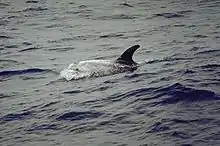
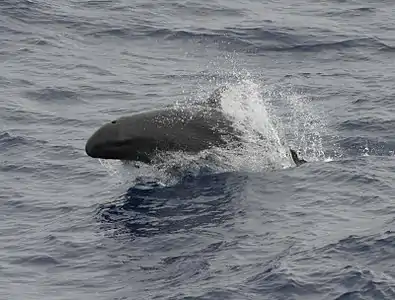
The order Cetacea includes whales, dolphins and porpoises. They are the mammals most fully adapted to aquatic life with a spindle-shaped nearly hairless body, protected by a thick layer of blubber, and forelimbs and tail modified to provide propulsion underwater.
- Suborder: Mysticeti
- Family: Balaenopteridae
- Subfamily: Balaenopterinae
- Genus: Balaenoptera
- Bryde's whale, B. edeni DD
- Genus: Balaenoptera
- Subfamily: Megapterinae
- Genus: Megaptera
- Humpback whale, M. novaeangliae VU
- Genus: Megaptera
- Subfamily: Balaenopterinae
- Family: Balaenopteridae
- Suborder: Odontoceti
- Superfamily: Platanistoidea
- Family: Phocoenidae
- Genus: Neophocaena
- Finless porpoise, N. phocaenoides DD
- Genus: Neophocaena
- Family: Delphinidae (marine dolphins)
- Genus: Grampus
- Risso's dolphin, G. griseus DD
- Genus: Pseudorca
- False killer whale, P. crassidens NT[24]
- Genus: Sousa
- Indo-Pacific humpback dolphin, S. chinensis DD
- Genus: Grampus
- Family: Phocoenidae
- Superfamily: Platanistoidea
Order: Chiroptera (bats)
The bats' most distinguishing feature is that their forelimbs are developed as wings, making them the only mammals capable of flight. Bat species account for about 20% of all mammals.
- Family: Vespertilionidae
- Subfamily: Myotinae
- Genus: Myotis
- Lesser mouse-eared bat, M. blythii LC[25]
- Long-fingered bat, M. capaccinii VU[26]
- Natterer's bat, M. nattereri LC[27]
- Genus: Myotis
- Subfamily: Vespertilioninae
- Genus: Eptesicus
- Botta's serotine, E. bottae LC
- Northern bat, E. nilssoni LC
- Genus: Otonycteris
- Desert long-eared bat, O. hemprichii LC
- Genus: Pipistrellus
- Kuhl's pipistrelle, P. kuhlii LC
- Rüppell's pipistrelle, P. rueppelli LC
- Genus: Rhyneptesicus
- Genus: Eptesicus
- Subfamily: Miniopterinae
- Genus: Miniopterus
- Common bent-wing bat, M. schreibersii VU[29]
- Genus: Miniopterus
- Subfamily: Myotinae
- Family: Rhinopomatidae
- Genus: Rhinopoma
- Lesser mouse-tailed bat, R. hardwickei LC
- Greater mouse-tailed bat, R. microphyllum LC
- Genus: Rhinopoma
- Family: Molossidae
- Genus: Tadarida
- European free-tailed bat, T. teniotis LC[30]
- Genus: Tadarida
- Family: Rhinolophidae
- Subfamily: Rhinolophinae
- Genus: Rhinolophus
- Mediterranean horseshoe bat, R. euryale NT[31]
- Greater horseshoe bat, R. ferrumequinum LC[32]
- Lesser horseshoe bat, R. hipposideros LC[33]
- Mehely's horseshoe bat, R. mehelyi VU[34]
- Genus: Rhinolophus
- Subfamily: Rhinolophinae
Order: Erinaceomorpha (hedgehogs and gymnures)
The order Erinaceomorpha contains a single family, Erinaceidae, which comprise the hedgehogs and gymnures. The hedgehogs are easily recognised by their spines while gymnures look more like large rats.
- Family: Erinaceidae (hedgehogs)
- Subfamily: Erinaceinae
- Genus: Hemiechinus
- Long-eared hedgehog, H. auritus LC
- Genus: Paraechinus
- Desert hedgehog, P. aethiopicus LC
- Genus: Hemiechinus
- Subfamily: Erinaceinae
Order: Lagomorpha (lagomorphs)
The lagomorphs comprise two families, Leporidae (hares and rabbits), and Ochotonidae (pikas). Though they can resemble rodents, and were classified as a superfamily in that order until the early 20th century, they have since been considered a separate order. They differ from rodents in a number of physical characteristics, such as having four incisors in the upper jaw rather than two.
Order: Rodentia
Rodents make up the largest order of mammals, with over 40% of mammalian species. They have two incisors in the upper and lower jaw which grow continually and must be kept short by gnawing. Most rodents are small though the capybara can weigh up to 45 kg (99 lb).
- Suborder: Sciurognathi
- Family: Sciuridae (squirrels)
- Subfamily: Sciurinae
- Tribe: Sciurini
- Genus: Sciurus
- Caucasian squirrel, Sciurus anomalus
- Genus: Sciurus
- Tribe: Sciurini
- Subfamily: Sciurinae
- Family: Gliridae (dormice)
- Subfamily: Leithiinae
- Genus: Dryomys
- Forest dormouse, Dryomys nitedula
- Genus: Eliomys
- Asian garden dormouse, E. melanurus LC[37]
- Genus: Dryomys
- Subfamily: Leithiinae
- Family: Dipodidae (jerboas)
- Subfamily: Allactaginae
- Genus: Allactaga
- Euphrates jerboa, Allactaga euphratica
- Genus: Allactaga
- Subfamily: Allactaginae
- Family: Spalacidae
- Subfamily: Spalacinae
- Genus: Nannospalax
- Palestine mole rat, Nannospalax ehrenbergi LC
- Genus: Nannospalax
- Subfamily: Spalacinae
- Family: Cricetidae
- Subfamily: Cricetinae
- Genus: Cricetulus
- Grey dwarf hamster, Cricetulus migratorius
- Genus: Mesocricetus
- Turkish hamster, Mesocricetus brandti
- Genus: Cricetulus
- Subfamily: Arvicolinae
- Genus: Microtus
- Günther's vole, Microtus guentheri
- Persian vole, Microtus irani
- Genus: Microtus
- Subfamily: Cricetinae
- Family: Muridae (mice, rats, voles, gerbils, hamsters)
- Subfamily: Deomyinae
- Genus: Acomys
- Cairo spiny mouse, Acomys cahirinus LC
- Genus: Acomys
- Subfamily: Gerbillinae
- Genus: Gerbillus
- Cheesman's gerbil, Gerbillus cheesmani
- Wagner's gerbil, Gerbillus dasyurus
- Gerbillus mesopotamiae
- Gerbillus nanus LC
- Genus: Meriones
- Sundevall's jird, Meriones crassus LC
- Libyan jird, Meriones libycus LC
- Persian jird, Meriones persicus
- Tristram's jird, Meriones tristrami
- Genus: Tatera
- Indian gerbil, Tatera indica
- Genus: Gerbillus
- Subfamily: Murinae
- Genus: Apodemus
- Persian field mouse, Apodemus arianus
- Broad-toothed field mouse, Apodemus mystacinus
- Black Sea field mouse, Apodemus ponticus
- Genus: Nesokia
- Bunn's short-tailed bandicoot rat, Nesokia bunnii
- Short-tailed bandicoot rat, Nesokia indica LC
- Genus: Apodemus
- Subfamily: Deomyinae
- Family: Sciuridae (squirrels)
Order: Sirenia (manatees and dugongs)
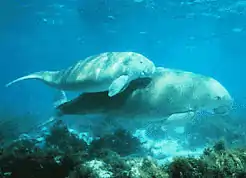
Sirenia is an order of fully aquatic, herbivorous mammals that inhabit rivers, estuaries, coastal marine waters, swamps, and marine wetlands. All four species are endangered.
- Family: Dugongidae
Order: Soricomorpha (shrews, moles, and solenodons)
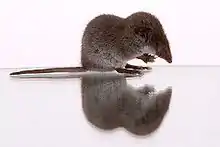
The "shrew-forms" are insectivorous mammals. The shrews and solenodons closely resemble mice while the moles are stout-bodied burrowers.
- Family: Soricidae (shrews)
- Subfamily: Crocidurinae
- Genus: Crocidura
- Bicolored shrew, C. leucodon LC
- Lesser white-toothed shrew, C. suaveolens LC[39]
- Genus: Crocidura
- Subfamily: Crocidurinae
Extirpated
The following species are locally extinct in the country:
References
- This list is derived from the IUCN Red List which lists species of mammals and includes those mammals that have recently been classified as extinct (since 1500 AD). The taxonomy and naming of the individual species is based on those used in existing Wikipedia articles as of 21 May 2007 and supplemented by the common names and taxonomy from the IUCN, Smithsonian Institution, or University of Michigan where no Wikipedia article was available.
- IUCN SSC Antelope Specialist Group (2017). "Gazella marica". IUCN Red List of Threatened Species. 2017: e.T8977A50187738.
- IUCN SSC Antelope Specialist Group (2017). "Gazella subgutturosa". IUCN Red List of Threatened Species. 2017: e.T8976A50187422.
- Weinberg, P. & Ambarli, H. (2020). "Capra aegagrus". IUCN Red List of Threatened Species. 2020: e.T3786A22145942.
- Lovari, S.; Herrero, J.; Masseti, M.; Ambarli, H.; Lorenzini, R. & Giannatos, G. (2016). "Capreolus capreolus". IUCN Red List of Threatened Species. 2016: e.T42395A22161386.
- Keuling, O. & Leus, K. (2019). "Sus scrofa". IUCN Red List of Threatened Species. 2019: e.T41775A44141833.
- Avgan, B.; Henschel, P. & Ghoddousi, A. (2016). "Caracal caracal". IUCN Red List of Threatened Species. 2016: e.T3847A102424310.
- Gray, T.N.E.; Timmins, R.J.; Jathana, D.; Duckworth, J.W.; Baral, H. & Mukherjee, S. (2016). "Felis chaus". IUCN Red List of Threatened Species. 2016: e.T8540A50651463.
- Sliwa, A.; Ghadirian, T.; Appel, A.; Banfield, L.; Sher Shah, M. & Wacher, T. (2016). "Felis margarita". IUCN Red List of Threatened Species. 2016: e.T8541A50651884.
- Breitenmoser, U.; Breitenmoser-Würsten, C.; Lanz, T.; von Arx, M.; Antonevich, A.; Bao, W. & Avgan, B. (2015). "Lynx lynx". IUCN Red List of Threatened Species. 2015: e.T12519A121707666.
- Stein, A. B.; Athreya, V.; Gerngross, P.; Balme, G.; Henschel, P.; Karanth, U.; Miquelle, D.; Rostro, S.; Kamler, J.F. & Laguardia, A. (2016). "Panthera pardus". IUCN Red List of Threatened Species. 2016: e.T15954A160698029.
- AbiSaid, M. & Dloniak, S.M.D. (2015). "Hyaena hyaena". IUCN Red List of Threatened Species. 2015: e.T10274A45195080.
- Chutipong, W.; Duckworth, J. W.; Timmins, R.; Willcox, D. H. A. & Ario, A. (2016). "Herpestes javanicus". IUCN Red List of Threatened Species. 2016: e.T70203940A45207619.
- Hoffmann, M.; Arnold, J.; Duckworth, J. W.; Jhala, Y.; Kamler, J. F. & Krofel, M. (2018). "Canis aureus". IUCN Red List of Threatened Species. 2018: e.T118264161A46194820.
- Boitani, L.; Phillips, M. & Jhala, Y. (2018). "Canis lupus". IUCN Red List of Threatened Species. 2018: e.T3746A119623865.
- Mallon, D.; Murdoch, J.D. & Wacher, T. (2015). "Vulpes rueppelli". IUCN Red List of Threatened Species. 2015: e.T23053A46197483.
- Hoffmann, M. & Sillero-Zubiri, C. (2016). "Vulpes vulpes". IUCN Red List of Threatened Species. 2016: e.T23062A46190249.
- McLellan, B. N.; Proctor, M. F.; Huber, D. & Michel, S. (2017). "Ursus arctos". IUCN Red List of Threatened Species. 2017: e.T41688A121229971.
- Roos, A.; Loy, A.; de Silva, P.; Hajkova, P. & Zemanová, B. (2015). "Lutra lutra". IUCN Red List of Threatened Species. 2015: e.T12419A21935287.
- de Silva, P.; Khan, W.A.; Kanchanasaka, B.; Reza Lubis, I.; Feeroz, M. M. & Al-Sheikhly, O.F. (2015). "Lutrogale perspicillata". IUCN Red List of Threatened Species. 2015: e.T12427A21934884.
- Kranz, A.; Abramov, A. V.; Herrero, J. & Maran, T. (2016). "Meles meles". IUCN Red List of Threatened Species. 2016: e.T29673A45203002.
- Do Linh San, E.; Begg, C.; Begg, K. & Abramov, A. V. (2016). "Mellivora capensis". IUCN Red List of Threatened Species. 2016: e.T41629A45210107.
- Abramov, A.V.; Kranz, A. & Maran, T. (2016). "Vormela peregusna". IUCN Red List of Threatened Species. 2016.
- Baird, R. W. (2018). "Pseudorca crassidens". IUCN Red List of Threatened Species. 2018: e.T18596A145357488.
- Juste, J. & Paunović, M. (2016). "Myotis blythii". IUCN Red List of Threatened Species. 2016: e.T14124A22053297.
- Hutson, A. M.; Spitzenberger, F.; Aulagnier, S.; Juste, J.; Karatas, A.; Palmeirim, J. & Paunovic, M. (2010). "Myotis capaccinii". IUCN Red List of Threatened Species. 2010: e.T14126A4399043.
- Gazaryan, S.; Kruskop, S.V. & Godlevska, L. (2020). "Myotis nattereri". IUCN Red List of Threatened Species. 2020: e.T85733032A22052584.
- Benda, P.; Srinivasulu, C.; Srinivasulu, B. (2019). "Rhyneptesicus nasutus". IUCN Red List of Threatened Species. 2019: e.T7935A22117147.
- Gazaryan, S.; Bücs, S. & Çoraman, E. (2020). "Miniopterus schreibersii". IUCN Red List of Threatened Species. 2020: e.T81633057A151216401.
- Benda, P. & Piraccini, R. (2016). "Tadarida teniotis". IUCN Red List of Threatened Species. 2016: e.T21311A22114995.
- Juste, J. & Alcaldé, J. (2016). "Rhinolophus euryale". IUCN Red List of Threatened Species. 2016: e.T19516A21971185.
- Piraccini, R. (2016). "Rhinolophus ferrumequinum". IUCN Red List of Threatened Species. 2016: e.T19517A21973253.
- Taylor, P. (2016). "Rhinolophus hipposideros". IUCN Red List of Threatened Species. 2016: e.T19518A21972794.
- Alcaldé, J.; Benda, P. & Juste, J. (2016). "Rhinolophus mehelyi". IUCN Red List of Threatened Species. 2016: e.T19519A21974380.
- Johnston, C.H.; Robinson, T.J.; Child, M.F. & Relton, C. (2019). "Lepus capensis". IUCN Red List of Threatened Species. 2019: e.T41277A45186750.
- Hacklande, K. & Schai-Braun, S. (2019). "Lepus europaeus". IUCN Red List of Threatened Species. 2019: e.T41280A45187424.
- Amori, G.; Aulagnier, S.; Hutterer, R.; Kryštufek, B.; Yigit, N.; Mitsain, G. & Palomo, L.J. (2016). "Eliomys melanurus". IUCN Red List of Threatened Species. 2016: e.T7619A115085446.
- Marsh, H. & Sobtzick, S. (2019). "Dugong dugon". IUCN Red List of Threatened Species. 2019: e.T6909A160756767.
- Hutterer, R.; Amori, G.; Krystufek, B.; Yigit, N.; Mitsain, G. & Palomo, L.J. (2010). "Crocidura suaveolens". IUCN Red List of Threatened Species. 2010: e.T29656A9511068.
- Durant, S.; Mitchell, N.; Ipavec, A. & Groom, R. (2015). "Acinonyx jubatus". IUCN Red List of Threatened Species. 2015: e.T219A50649567.
- Werner, N.Y.; Rabiei, A.; Saltz, D.; Daujat, J. & Baker, K. (2016). "Dama mesopotamica (errata version)". IUCN Red List of Threatened Species. 2016: e.T6232A97672550. Retrieved 6 October 2020.
- Kaczensky, P.; Lkhagvasuren, B.; Pereladova, O.; Hemami, M. & Bouskila, A. (2015). "Equus hemionus". IUCN Red List of Threatened Species. 2015: e.T7951A45171204.
- IUCN SSC Antelope Specialist Group (2017). "Oryx leucoryx". IUCN Red List of Threatened Species. 2017: e.T15569A50191626.
- Bauer, H.; Packer, C.; Funston, P. F.; Henschel, P. & Nowell, K. (2016). "Panthera leo". IUCN Red List of Threatened Species. 2016: e.T15951A115130419.
- Kock, D. (1990). "Historical record of a tiger, Panthera tigris (Linnaeus, 1758), in Iraq". Zoology in the Middle East. 4: 11–15. doi:10.1080/09397140.1990.10637583.
- Hatt, R. T. (1959). The mammals of Iraq. Ann Arbor: Museum of Zoology, University of Michigan.
External links
- "Animal Diversity Web". University of Michigan Museum of Zoology. 1995–2006. Retrieved 22 May 2007.
